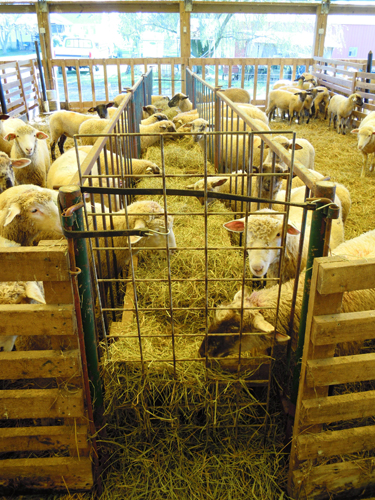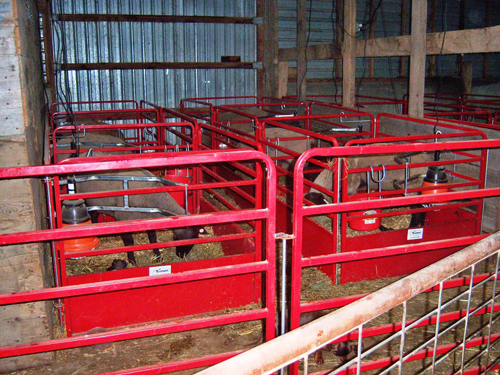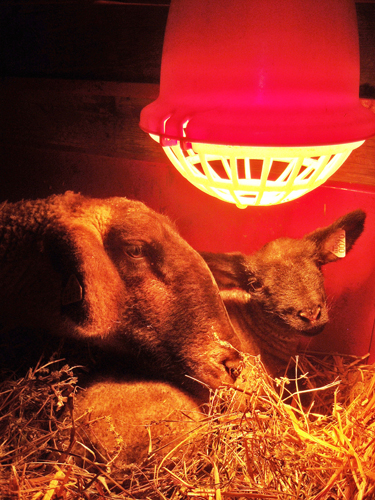For many sheep producers, lambing has already started or is right around the corner. Be it commercial producers aiming for the high of the Easter market, club lamb producers setting their sights on summer shows or seedstock sheep folks raising rams that are mature enough to be turned out with ewes for the fall breeding season, there are several scenarios in which sheep producers utilize the time-tested practice of shed lambing.
According to the website sheep101.info, a lambing system specifies when lambing will occur (what season or months), how often a ewe will lamb (annual vs. accelerated), and how and where lambing will take place (shed vs. pasture). While there’s more than one way to raise sheep, producers should match the lambing system to their goals, objectives, resources and market demand.
Shed lambing is simply lambing indoors and is a very common system for lambing. It provides the ewe and her lamb(s) (also known as sheep “families”) protection from the elements as well as from predators. It also allows for earlier lambing during times of cold or inclement weather.
Shed lambing requires a building large enough to handle all of the essential areas of lambing indoors; Mike Caskey, Pipestone Lamb and Wool Program Coordinator, recommends a barn layout that includes drop pens, lambing jugs, mixing pens and a pen for bum lambs. The area encompassing the drop pens and laming jugs is, ideally, a warm 32 to 40 degrees F and has adequate ventilation at 33 to 133 CFM/1,000 lb. ABW, depending on the size of the barn. Mixing pens are set up for families to become acclimated both to colder conditions and integrating with other sheep. Since shed lambing often includes the use of heat lamps in the jugs, mixing pens are usually also set up inside to make the adjustment to the colder weather less stressful. From the mixing pen, groups of families are frequently moved to larger areas that commonly include adequate shelter and access to the outdoors.
Sheep 101 points out that early-born lambs are often creep fed and finished on concentrate rations. Lambs born in the winter usually grow faster than those born later in the year and may hit a higher market; historically, sheep prices are higher in the first half of the year than the last, but, correspondingly, the cost of gain of these early-borns is also usually higher than their later-born counterparts.
Shed Lambing Considerations
While shed lambing can be advantageous for highly-productive flocks, it’s not for every shepherd. Several items should be taken into consideration when choosing your lambing system. The first is finances; one of the main drawbacks to shed lambing is cost. In addition to the cost of lambing facilities, including a building, labor and feed costs can be higher than pasture lambing settings. The infrastructure and labor requirements of shed lambing should be off set with a higher lambing percentage; prolific breeds are sometimes preferred for shed lambing situations.
Even with the best of facilities, early/shed lambing may require near round-the-clock care of livestock. Responsibilities may include making sure the ewes about to lamb are in the drop pens, monitoring and helping newborns nurse or bottle feeding to prevent the early onset of starvation, moving families from the drop pens to jugs to mixing pens, and feeding and watering every pen. On the other hand, identifying families and keeping records is easier in a shed lambing setting than a pasture lambing scenario and, therefore, the tendency may be to do more record keeping.
With a small to medium sheep flock, shed lambing is very workable, even if it is labor intensive in its own way. With a large number of sheep potentially synchronized to lamb at the same time, however, juggling livestock and space so there is always available pens may be a challenge. As the flock grows, space and workload may become a concern. To alleviate this issue, many producers are splitting breeding groups so lambing seasons occurs at different times of the year. For example, Don Van Nostran, Will-O-Wood Farm, Athens, Ohio, lambs his ewes out in different groups four times a year: in September for 21 days, November for 21 days, February-March for 45 days and in May they lamb out the ewe lambs. “I enjoy lambing for about three weeks at a time, and lambing this way spreads the lambs out more and gives me a good range of weights,” Don explains. Also, lambing multiple times a year allows for more utilization of their facilities.
Shed lambing may also make livestock more susceptible to illness because of the confinement system. Issues like crowding, mis-mothering, mastitis, scours and pneumonia tend to be elevated with early/shed lambing because sheep are confined into smaller areas. Gate’s Practical Guide to Sheep Disease Management explains that, characteristically, mortality caused by disease in sheep operations is highest in lambs from birth to 30 days of age. The book goes on to encourage producers to prevent exposure of livestock to disease-producing organisms and situations through the practice of good sanitation and maintenance of a healthy environment.
Recommendations for sanitation practices start with cleaning, disinfecting and re-bedding jugs between ewes. “The same rational is applicable to the drop lot, since pregnant ewes spend a large part of their time lying in whatever is provided,” Gate’s Practical Guide to Sheep Disease Management says. “The ewe’s teats can be expected to be laden with bacteria that can cause mastitis in the ewe or scours in the newborn nursing lamb.” Additional management practices include preventing extreme moisture and manure build-up in pens as well as preventing manure contamination of feeding areas.
So whether shed lambing for commercial production, raising club lambs or making seedstock, shepherds should match their lambing system to their lifestyle.





